中国文化概况名词解释
中国文化概论名词解释

中国文化概论名词解释1.广义文化:它是指人类在长期的历史发展中共同创造并赖以生存的物质与精神存在的总和。
2.狭义文化:又称人文文化。
它是某一社会集体民族或阶层在长期历史发展中经传承属积而自然凝聚的共有的人文精神及其物质体现总体体系。
3.文化产品:它分广义的文化产品和狭义的文化产品两种。
广义的文化产品指人类创造的一切提供给社会的可见成品既包括物质产品也包括精神产品狭义的文化产品专指精神产品纯粹实用的生产工具生活器具能源资材等一般不称为文化产品。
4.文化涵:它是把一些不屑于狭义文化的事物中所具有的人文特性凸现出来称为事物的文化涵。
如筷子属于生活用品只有实用功能。
但它有产生的历史背景与民族饮食特点的适应性也就是其样式的民族化各时代对其美化的方式有关它的传说故事以及命名的由来等等这些都属于它的人文精神属性的表现所以就是它的文化涵。
我们平时说的“筷子文化”就是针对所指事物的文化涵而言的。
5.文化现象指的是人类文化发展过程中呈现出的某种外部状态和联系。
6.文化事象在某一历史时期某一国家民族或地域文化发展中带有典型和标志作用的事情反复出现时这种含规律性的现象称为文化事象。
7.文化观念一个时期某一阶层或某一行业的人群对文化问题所持的态度和看法或在某一文化事象里所表现的意识形态诸如价值观审美观等等称作文化观念。
8.文化思潮某种文化观念及与之相关的文化事象在某一特定时期在一定的背景下对社会产生广泛影响为多数人所赞同和奉行形成一种潮流称作文化思潮。
9.文化政策指一定时代一定的社会条件下行政机构对文化领域的问题所颁布的相关规定和对策原则。
10民族文化在一个多民族的国家里不同的民族都有自己不同于其他民族的文化文化的差异与特色是划分民族的标志之一而民族又是文化划分的依据。
但由于历史发展条件和文化本身的结构功能等的特点不同民族的文化在发展中都具有鲜明的民族特色和地域特色。
正因为每个民族文化都是独特的所以作为一种价值而言它们均处于平等的地位。
中国传统文化概观

一、名词解释1、物质文化:是指为了满足人类生存和发展需要所创造的物质产品及及生产活动本身,这些产品包括饮食、服饰、建筑、交通、房屋、生产工具以及乡村、城市等。
2、制度文化:是人类为了生存发展的需要而创制出来的有组织得规范体系。
主要包括法律制度、礼仪俗规、经济制度、政治制度、人才培养选拔制度等内容。
3、行为文化:是指人的生活方式、实际行为、态度、价值等,是人际交往中约定俗成的行为模式,主要以礼俗、民俗、风俗等形态表现出来。
4、精神文化:是人类在社会实践和意识活动中创造出来的价值观、审美观、伦理观、思维方式等。
5、起一成文说:这个观点是宋人郑樵的主张。
他认为汉字起源于“一”。
他的这种学说是建立在“道生于一,一生二,二生三,三生万物”、“一阴一阳谓之道”等古代哲学思想基础上。
二、简答题1、简述广义文化和狭义文化。
(P3页)答:广义的文化,主要是指社会和人在历史上一定的发展水平,表现为人们生活活动的种种类型和形式,以及人们所创造的物质和精神财富。
广义文化的涵盖面非常大,几乎包括了人类生活的各个方面。
狭义的文化,主要是指人类精神创造活动及其成果,包括信仰、风俗、艺术、法律、制度等等。
泰勒的文化定义就是狭义文化的经典界说。
2、简述汉语的特点。
(P12页)答:(1)在语音方面,汉语的音节可以分为生母、韵母、声调三个部分。
(2)在汉语词汇方面,也有独特的特点:一是基本词汇有很大的稳定性;二是词汇发展过程中新词不断产生;三是词汇发展过程中有些词汇消亡;四是单音词向复音词发展。
(3)在语法方面,主要的特点是汉语缺乏严格意义的形态变化,即缺乏表示语法意义的词形变化。
名词没有格的变化,也没有性和数的区别。
动词不分人称,也没有时态。
虚词是汉语表达语法意义的重要手段。
虚词的数量少,但是使用频率高,运用复杂,在汉语中有着重要的地位和作用。
3、分析汉语成语“四字格”形式的文化内涵。
(P16页)答:(1)讲究对称,这是汉民族非常重要的文化心理,而四字格最能体现“以偶为佳”的要求;(2)字数上的对偶和结构上的对称,还有音律上的音节整齐匀称,声调的平仄相间;(3)汉民族的言语习惯,四字格是汉语言语习惯之一,从原始歌谣到《诗经语言艺术》再到秦汉散文,大多都采用四字格的形式表达。
《中国文化概论》中的百科名词解释
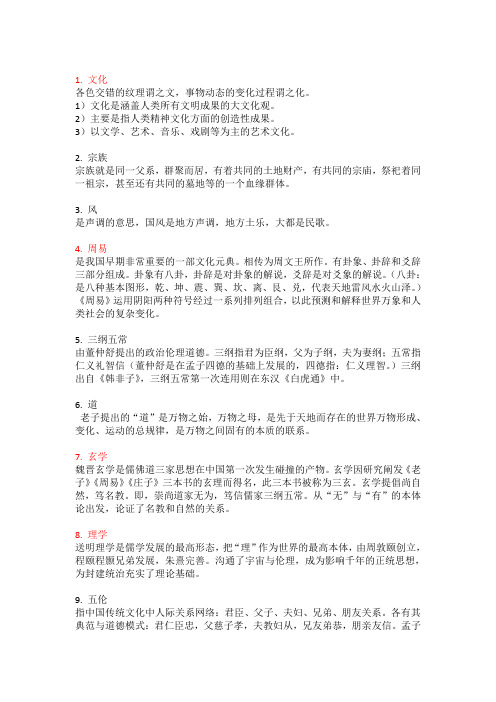
1. 文化各色交错的纹理谓之文,事物动态的变化过程谓之化。
1)文化是涵盖人类所有文明成果的大文化观。
2)主要是指人类精神文化方面的创造性成果。
3)以文学、艺术、音乐、戏剧等为主的艺术文化。
2. 宗族宗族就是同一父系,群聚而居,有着共同的土地财产,有共同的宗庙,祭祀着同一祖宗,甚至还有共同的墓地等的一个血缘群体。
3. 风是声调的意思,国风是地方声调,地方土乐,大都是民歌。
4. 周易是我国早期非常重要的一部文化元典。
相传为周文王所作。
有卦象、卦辞和爻辞三部分组成。
卦象有八卦,卦辞是对卦象的解说,爻辞是对爻象的解说。
(八卦:是八种基本图形,乾、坤、震、巽、坎、离、艮、兑,代表天地雷风水火山泽。
)《周易》运用阴阳两种符号经过一系列排列组合,以此预测和解释世界万象和人类社会的复杂变化。
5. 三纲五常由董仲舒提出的政治伦理道德。
三纲指君为臣纲,父为子纲,夫为妻纲;五常指仁义礼智信(董仲舒是在孟子四德的基础上发展的,四德指:仁义理智。
)三纲出自《韩非子》,三纲五常第一次连用则在东汉《白虎通》中。
6. 道老子提出的“道”是万物之始,万物之母,是先于天地而存在的世界万物形成、变化、运动的总规律,是万物之间固有的本质的联系。
7. 玄学魏晋玄学是儒佛道三家思想在中国第一次发生碰撞的产物。
玄学因研究阐发《老子》《周易》《庄子》三本书的玄理而得名,此三本书被称为三玄。
玄学提倡尚自然,笃名教。
即,崇尚道家无为,笃信儒家三纲五常。
从“无”与“有”的本体论出发,论证了名教和自然的关系。
8. 理学送明理学是儒学发展的最高形态,把“理”作为世界的最高本体,由周敦颐创立,程颐程颢兄弟发展,朱熹完善。
沟通了宇宙与伦理,成为影响千年的正统思想,为封建统治充实了理论基础。
9. 五伦指中国传统文化中人际关系网络:君臣、父子、夫妇、兄弟、朋友关系。
各有其典范与道德模式:君仁臣忠,父慈子孝,夫教妇从,兄友弟恭,朋亲友信。
孟子首先提出这一概念。
10. 天人合一天人合一是中国传统文化中提出的一个重要思想。
中国文化概论--名词解释

自考“中国文化概论”学习笔记--名词解释广义的文化:文化是人类在长期的历史发展中共同的创造并赖以生存的物质和精神存在总和。
狭义的文化:专指人类的精神创造,它着重人的心态部分。
文化产品:广义的文化产品:方义的文化产品指的是人类创造的一切提出供给社会的可见成品,即包括物质产品,也包括精神产品。
文化内涵:把一些不属于狭义文化的事物中所具有的人文特性称为事物的文化内涵,平时所说的筷子文化,扇子文化等等是针对所指称事物的文化内涵现时言的。
文化事象:文化事象往往是思想观念及其物化形式的综合,它不但具有外在的特色而且含有观念的特色文化事象对人类社会存在和发展以及对其他文化事象所起的作用,称作文化事象的功能。
文化思潮:某种文化观念及与之丰关的文化事象,在某一特定时期在一定的背景下,对社会产生广泛影响,为多数人所赞同和奉行形成一种潮流,称作文化思潮。
文化政策:指一定时代,一定的社会条件下。
行政机构对文化领域的总是所颁布的相关规定和对策原则。
中国的生产经济文化:指在中国传统的农耕自然经济的基础上,所产生发展和连续传承的一种社会形态又称农业文明。
二十四节气文化:它是我国南北农业区所共同发明的,也为两地的共同遵守。
农政思想的核心是:政绩和鄙农观。
政绩观:指历代统治者把农业收成的丰款,当做考察国计民生的好坏和自己得政或失政的一个标准。
鄙农观:指确立以农为本的地质学则和制订一套劝勉农事的治国方略。
行业组织:又称行会是手工业者的自发组织,行会的职能是互助共济保护行业利益。
家庭:指共同居住,经济协助。
有血缘关系的社会集团。
家义务兵是由出生和婚姻形成的亲属关系。
里面包括血缘关系和姻缘关系。
血缘关系是由出生形成的纵向谱系性纽带。
血缘九族:即以本人为基准向上向下各推衍四代共九代为九族。
血亲五服制:即以本人为基准向上推四代的直接系亲属称祖先。
中国传统科学技术:是一个历史概念,就广东省义而言,它可以被界定不在中国农业社会中曾存在的各种传统科学和技术成果。
中国文化概况
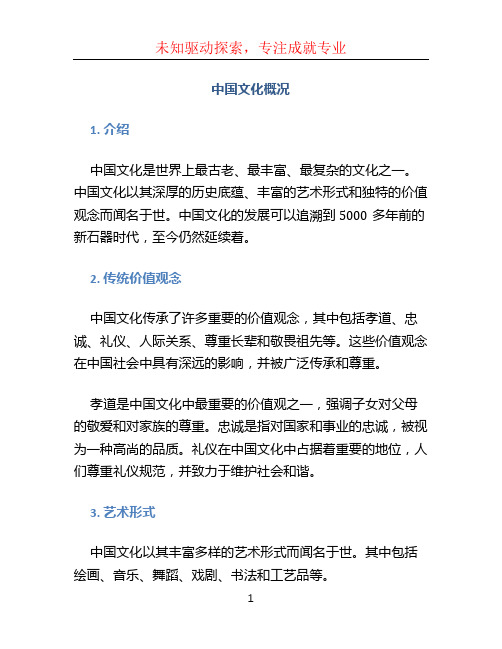
中国文化概况1. 介绍中国文化是世界上最古老、最丰富、最复杂的文化之一。
中国文化以其深厚的历史底蕴、丰富的艺术形式和独特的价值观念而闻名于世。
中国文化的发展可以追溯到5000多年前的新石器时代,至今仍然延续着。
2. 传统价值观念中国文化传承了许多重要的价值观念,其中包括孝道、忠诚、礼仪、人际关系、尊重长辈和敬畏祖先等。
这些价值观念在中国社会中具有深远的影响,并被广泛传承和尊重。
孝道是中国文化中最重要的价值观之一,强调子女对父母的敬爱和对家族的尊重。
忠诚是指对国家和事业的忠诚,被视为一种高尚的品质。
礼仪在中国文化中占据着重要的地位,人们尊重礼仪规范,并致力于维护社会和谐。
3. 艺术形式中国文化以其丰富多样的艺术形式而闻名于世。
其中包括绘画、音乐、舞蹈、戏剧、书法和工艺品等。
中国绘画以传统水墨画为主,以山水画、花鸟画和人物画为代表。
这些作品通常以简洁、含蓄和意境化的风格表达作者的情感和思想。
乐器演奏和声乐在中国音乐中占据重要地位,其中包括古筝、琵琶、二胡和京剧等。
舞蹈则有古典舞和民间舞等多种形式。
京剧是中国最著名的戏曲艺术形式之一,结合了演唱、舞蹈、表演和武术等元素。
中国书法是一门独特的艺术形式,强调书写的美感和审美价值。
书法家运用毛笔,通过书写汉字来表达自己的情感和理念。
中国工艺品丰富多样,包括瓷器、织锦、漆器、陶瓷和剪纸等,这些工艺品体现了中国古代文化的精髓和精湛技艺。
4. 文化节日和传统习俗中国有许多重要的文化节日和传统习俗,这些活动丰富了中国文化的内涵。
春节是中国最重要的传统节日之一,通常在农历正月初一庆祝,它标志着新年的开始,人们会进行庆祝活动,包括家庭聚会、放鞭炮、赏花灯和舞龙等。
中秋节是中国另一重要的传统节日,在农历八月十五庆祝。
这一天,家人会团聚共度,并品尝传统的月饼,同时也欣赏月亮的美丽。
龙舟节是为了纪念古代爱国诗人屈原的节日,每年农历五月初五庆祝。
人们会进行龙舟竞赛,并吃粽子以纪念屈原投江以示痛惜。
中国文化概况复习重点资料

一、名词解释1、the Grand CanalThe most f amous man-made canal in China is the Grand Canal between Beijing and Hangzhou,1801km in length.It Passes through the city of Tianjin and f our provinces and links f ive major rivers.The canal was open to navigation over 1000 years ago.It played and important role in f acilitating trade between the south and the north and was regarded as the country's transportation and inf orm ation"highway"before the advent of the railway.2、the White Horse TempleThe White Horse Temple,located 21 kilometres east of the Louyang City, Henan Province,was the f irst of f i cially built Buddhist temple in China in the Eastern Han Dynasty.It was named af ter the white horse that carried the Buddhist scriptures from India to Luoyang, then the capital of the country.3、the Book of SongsThe Book of Songs is a collection of China's 305 oldest poems f rom the early Western Zhou Dynasty to the middle Spring and Autumn Period, and is regarded as the earliest realistic literature in China.4、the Four Literary EminencesThe Four Literary Eminences ref er to the f our pre-eminent poets of the early Tang Dynasty, Wang Bo, Y ang Jiong, Luo Binwang, and Lu Zhaolin, the pioneers of Tang poetry.Their poems, in a ref ined language, boast beautif ul tonal patterns and rhyme schemes.5、Beijing OperaBeijing Opera is regarded as China's national opera.Singing, recitation,acting, and acrobatic f ighting are the f our artistic means and the f our basic skills of Beijing Opera.6、Shaanxi OperaShanxi Opera,the oldest of all the Chinese operas that are still in existence today, is the typical opera popular of Shaanxi Province.7、Y ue Opera(越剧)Y ue Opera is one type of traditional local operas that originated in Shengxian County,Zhejiang Province, but it is popular throughout Zhejiang Province and Shanghai as well as in many large and medium-sized cities throughout the country.8、Y ue Opera(粤剧)Y ue Opera is one type of traditional local operas,popular in Guangdong and Guangxi provinces and in Chinese communities in South Asia and America.9、Private SchoolsA private school refers to a school set up by a family, generally with just one teacher who gave individual tuition, and with neither set textbooks nor specif ied time span of study.10、Official SchoolsOff icial Schools began during the Western Zhou Dynasty, and were sponsored by the off ici al constitution called xiangxue.Only children of nobles were admitted.The off icial schooling system included a central school and local schools in diff erent admin istrative regions.The teaching materials were cent ered on The Four Books and The Five Classics.11、Ping-Pong DiplomacyIn April 1971, at the 31st World Table Tennis Tournament in Japan, the Chinese team invited the United States table tennis(Ping-Pong)team to visit China.In 1972, the Chinese table tennis team accepted the invitation to pay return visit to the United States.The f riendly exchange between the table tennis players of the two countries opened the door to warmer relations between the table tennis players of the two countries opened the door to warmer relations between the Chinese and American nations, and become known as "Ping-Pong Diplomacy".12、Spring FestivalSpring Festival, also called the Chinese New Y ear,is China's most important f estival that falls on the 1st day of the 1st lunar month each year.Family members gather just as they do f or Christmas in the West.13、Lantern FestivalThe Lantern Festival, celebrated on the 15t h day of the f irst lunar month, is closely related to the Spring Festival.It marks the end of the New Y ear cel ebrations, f ollowing which lif e returns to normal.14、the Silk RoadThe Silk Road was the main trade route running through Asia in ancient times.It started f rom the Weishui V alley in the east and ended on the east coast of the Mediterranean,f rom where it led to various places around Europe.From the Western Han Dynasty on,China and the West was f ormed, and cultural exchanges and f ri endly visits were promoted.15、Chinese batikBatik is a traditional Chinese f olk art, which combines painting and dyeing.It presents a variety of ethnic styles and is most popular among the Buyi, the Miao and the Y ao ethnic group.16、HuabiaoHuabiao are paired ceremonial columns erected in front of palace or tomb, usually carved with dragon and phoenix patterns, with a transverse-engraved stone slab on its top.17、the BundThe 1.5 km belt along the Huangpu River between Waibaidu Bridge and East Y an'an Road is called the Bund.Here, those European-style buildings, once housed f oreign consulates,banks ,commercial f irms and newspaper off ices, are still in use today.When evening comes, the banks of the Huangpu River are busy with strolling young couples and throngs of f oreign tourists.二、简答1、The development of ancient C hinese philosophyIn general,ancient Chinese philosophy progresses through the f ollowing periods:①The philosophy in pre-Qin timesThe philosophy in pre-Qin times was marked by the emergence of various anci ent philosophical views.The most inf luential schools were Conf uci anism,Taoism, Mohism and Legalism.②The orthodox philosophy during the Han Dynasty③Metaphysics during the Wei and Jin dynasties④The Buddhist philosophy during the Sui and Tang dynasties⑤Neo-Conf uci anism in Song and Ming dynasties⑥Application philosophy in the Ming and Qing dynasties2、The Features of C hinese food①colour, aroma, and taste②cooling method③seasonings④Y in-yang principle⑤Medicinal f unction⑥Eight Regional Cuisines4、The classification of C hinese TeaAlthough there are hundreds of varieties of Chinese tea, they can be classi f i ed into f ive basic categories according to the different techinque involved in processing the tea.The f ive types are green tea, black tea, oolong tea,compressed tea, and scented tea.Some minor types are white tea and yellow tea.The Development of C hinese Philosophy(中国哲学的发展)⏹The philosophy in Pre-Qin times (先秦子学)⏹The orthodox philosophy during the Han Dynasty (两汉经学)⏹Metaphysics during the Wei and Jin dynasties (魏晋玄学)⏹The buddhist philosophy during the Sui and Tang dynasties (隋唐佛学)⏹Neo-confucianism in Song and Ming dynasties (宋明理学)⏹Application philosophy in the Ming and Qing dynasties (明清实学)Chinese Religions(中国的宗教)⏹Indigenous(本土的):Taoist Religion(道教)When the Eight Immortals cross the sea,each demongstrates his/her divine power(八仙过海,各显神通).Dragon-Tiger Mountain is recognised as the most sacred mountain of the Taoist religion.It is the birthplace of the Taoist religion.⏹Foreign:Buddhism,Islam,ChristianityBuddhism(佛教)▪During the Sui and Tang dynasties, Buddhism entered its golden age.▪The theory of Buddhism is based on the theory of samsara (轮回),meaning that living beings orbit around the six spheres of heaven, hell and earth, just like an ever-turning wheel. The path of a Buddhist is to achieve enlightment.▪The cornerstone(观点) of Buddhist philosophy is the view that all lif e is suffering.▪The doctrine of Four Noble Truths (四谛):lif e is suf f ering, the cause of suffering is desire, the answer is to quench (抑制)desire, the way to this end is to f ollow the Eight-Fold Path (八正道).▪The Four Heavenly Kings(四大天王) the statue of Maitreya(弥勒佛:laughing Buddha)The Eighteen Arhats(十八罗汉)▪Buddhism TemplesThe First Buddhist Temple—The White Horse Temple⏹The White Horse Temple, located 21 km east of the Luoyang City, Henan Province, was the f irst off i cially built Buddhisttemple in China in the Eastern Han Dynasty.⏹It was named af ter the white horse that carri ed the Buddhist scriptures f rom India to Luoyang, then the capital of the country. The f amous Buddhist mountains:of the many Buddhist mountains, mount Wutai,mount Emei,mount Putuo and mount Jiuhua are accepted as the f our sacred Buddhist mountains in China.Classical LiteratureDating back to 1000 B.C, the f our civilization of China, India, Egypt and Greece have produced verse in different f orms and f or di ff erent pueposes.chinese verse centred on human lif e and religion and has been one of the two orthodox genres of Chinese literature(the other one is prose).Poetry, one of the earliest artistic f orms, originated f rom f olk songs bef ore the existence of written Chinese. Its contents evolved out of people’s everyday lif e, and ref l ected their labor and entertainment. The Book of Songs (《诗经》) and Poetry of the South (《楚辞》) are regarded as the two peaks of China’s earliest literary.The Book of Songs (《诗经》):A collection of China’s 305 oldest poems f rom the Early Western Zhou Dynasty to the middle Spring and Autumn Period; regarded as the earliest realistic literature in China.Poetry of the South (《楚辞》):•Poetry of the South is derived f rom the songs of the southern state of Chu during the Warring States Period.•It pioneered romanticism in Chinese poetry.•The verse of Poetry of the South is f reer than those of The Book of Songs. It is not f ixed to f our characters per line, and the character of“xi” (兮) is of ten put in the middle or the end of some lines.The Prose of the Pre-Q in Period (先秦子学)▪The prose in the pre-Qin period includes historical prose (历史散文) and philosophical prose (诸子散文).▪Historical prose :The Book of History《尚书》;Spring and Autumn Annals《春秋》;Zuo’s Commentary 《左传》;Intrigues of the Warring States 《战国策》;Discourses of the States 《国语》▪Philosophical prose:Lao Zi (Dao De Jing), Mo Zi, Mencius, Zhuang Zi,The Analects of Conf ucius(老子,《道德经》)Han Dynasty Literature(汉代文学)▪hanfu (汉赋)▪Representative Hanf u:On Faults of Qin 《过秦论》;Records of the Grand Historian《史记》▪yuefu folk songs (汉乐府民歌)It f eatures f ive-character lines and ref lects the reality and lif e of lower-class working people.▪Outstanding Y uef u Folk songs (乐汉府民歌):Southeast the Peacock Flies 《孔雀东南飞》;The Ballads of Mulan 《木兰诗》The Literature in the Wei, Jin, Sout hern and Northern Dynasties(魏晋南北朝)▪A new genreThe stories recording spirits and anecdotes (志人志怪小说)▪Outstanding works of this periodThe Peach Blossom Spring 《桃花源记》The Literary Mind and the Carving of Dragons《文心雕龙》The Tang Poems(唐诗)•The Complete Anthology of Tang Poems《全唐诗》(The biggest-ever collection of Chinese poetry.)•The development of poet ry in the Tang Dynasty can be cl assif i ed into f our stages: Early Tang, High Tang, Mid Tang and late Tang•Li Bai(李白), the “Celestial Poet (诗仙)”, has long been regarded the greatest romantic poet in Chinese literature.•In his poems, imagination, exaggeration, diction and sonorous rhythms are blended eff ortlessly.•Thinking in the Silent Night 《静夜诗》•Hard is the Road to Shu 《蜀道难》•Dreaming of Sightseeing in the Tianmu Mountains《梦游天姥吟留别》•Du Fu(杜甫)and his poems•Du Fu, the “Saint Poet (诗圣)”, has been considered as the greatest realistic poet in Chinese literature.He developed a depressing and meticulous literary style.•“Three off icers”(三吏) :The Xin’an Off icer 《新安吏》;The Shihao Off icer《石壕吏》;Off i cer at Tongguan Pass《潼关吏》•“Three Partings” (三别) :Parting of the Newly-wed《新婚别》;Parting of the Old《垂老别》;Parting of the Homeless《无家别》Poets in two categories: f rontier poets (边塞诗人), represented by Gao Shi and Cen Shen; pastoral poets (田园诗人) represented by Meng Haoran and Wangwei.Fiction in the Ming and Q ing Dynasty(明清小说)▪Four f amous Chinese classics of literature:Romance of the Three Kingdoms 《三国演义》;Water Margin《水浒传》;Journey to the West《西游记》;Dream of the Red Mansions《红楼梦》(explicit)▪Townsf olk literatureThree V olumes of Words and Two V olumes of Slapping 《三言二拍》▪Satirical novelThe Scholars 《儒林外史》Strange Tales f rom a Scholar’s Studio 《聊斋志异》Great Writers of the 20th Century(20世纪伟大的作家)•Two peaks of Chinese modern literatureThe May 4th Movement(五四运动)in 1919and the opening-up policy in 1978 have produced two peaks of literary prosperity.Eight great writers of the 20th century:Lu Xun, Guo Moruo, Mao Dun, Ba Jin, Laoshe, Cao Y u, Shen Congwen and Ai QingTraditional OperasBeijing Opera(京剧)•Originally Beijing Opera was a form of local theatre. It then spread across the country and becam e the national opera of China.•Singing, recitation, acting, and acrobatic f ighting (唱、念、做、打) are the f our artistic means and the f our basic skills of Beijing Opera.•Each action by the perf ormer is highly symbolic. Feelings and ideas are of ten expressed through these symbolic motions. Sheng, Dan, Jing, and Chou•The characters of Beijing Opera are classi f ied according to sex, age, disposition, prof ession, and social status.•There are f our major roles in Beijing Opera today: sheng (male), dan (f emal e), jing (painted f ace, male) and chou (clown). Other Major Traditional Chinese Opera :Kunqu Opera;Shaanxi Opera;Chuan Opera;Y ue Opera;Huangmei Opera;Y ue OperaThe Development of Traditional Education (传统教育的发展)Private Schools⏹A private school ref ers to a school set up by a f amily, clan, or teacher that generally had just one teacher who gave individ ualtuition, and that had no set textbooks and no specif i ed time span of study.⏹In the Spring and Autumn Period, private schools prevailed and many scholars of different schools of thought spread theirteaching in this way. Among them, the private school run by Conf ucius was the largest and most inf luential.Official Schools⏹Off i cial schools began during the Western Zhou Dynasty, and were sponsored (创办) by the off icial constitution calledXiangxue (乡学: off i cial institutions). Only children of nobles were admitted.⏹The off icial schooling system included a central school and local schools in dif ferent administrative regi ons.⏹The teaching materials were cent ered on the Four Books and the Five Classics (四书五经).{ Four Books:The Great Learning《大学》;The Doctrine of Mean ;《中庸》The Analects of Conf ucius《论语》;Mencius《孟子》;Five Classics:The Book of Poems 《诗经》The Book of History《尚书》;The Book of Rites《礼记》;The Book of Changes《易经》;The Spring and Autumn Annals《春秋》}Higher schoolUndergraduate studies cover basic courses, speci alty basic courses, and specialty courses. college and university students also have a wide choi ce of extracurri cular(课外)activities and every institution of higher learning has a student association practicing “self-managem ent,self-education,and self-servi ce.”Ancient Science and TechnologyThe Four Major Inventions:Compass;Papermaking;Gunpowder;PrintingA compass vehicle (指南车) was an ancient Chinese vehicle equipped with many gear wheels and a wooden f igure that always pointed south no matter which direction the vehicle went. It’s an earlier and more primitive f orm of the compass.Traditional C hinese Medicine(TCM)Traditional Chinese painting, Beijing Opera, and traditional Chinese medicine are known throughout the world as the three treasures of China.Traditional Chinese medicine is very diff erent from Western Medicine in its means of diagnosis, treatment and its composition of drugs and prescriptions(药方).•Listening, smelling, inquiring, observing, and f eeling the pulse (望、闻、问、切) are f our diagnostic (诊断的) methods in traditional Chinese medicine.Li Shizhen (李时珍) of the Ming Dynasty, whose monument al masterpiece, Compendium of Meteria Medica (本草纲目),eight hundred and thirty-f ive years earlier than the next pharmacopeia(药典)in the world。
中国文化概论名词解释
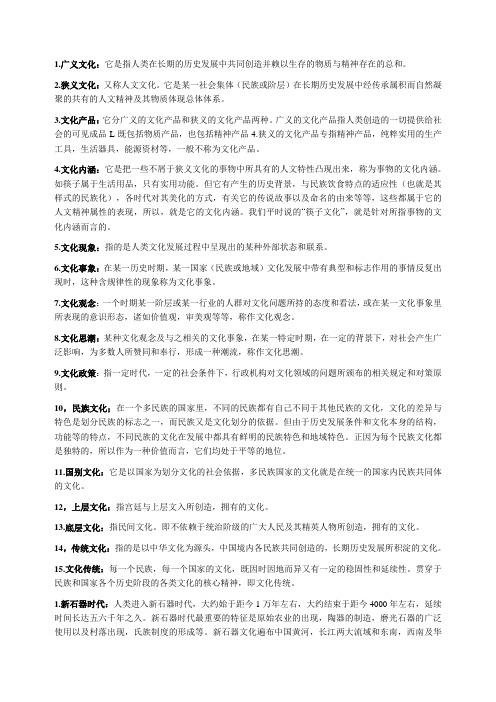
1.广义文化:它是指人类在长期的历史发展中共同创造并赖以生存的物质与精神存在的总和。
2.狭义文化:又称人文文化。
它是某一社会集体(民族或阶层)在长期历史发展中经传承属积而自然凝聚的共有的人文精神及其物质体现总体体系。
3.文化产品:它分广义的文化产品和狭义的文化产品两种。
广义的文化产品指人类创造的一切提供给社会的可见成品L既包括物质产品,也包括精神产品4.狭义的文化产品专指精神产品,纯粹实用的生产工具,生活器具,能源资材等,一般不称为文化产品。
4.文化内涵:它是把一些不屑于狭义文化的事物中所具有的人文特性凸现出来,称为事物的文化内涵。
如筷子属于生活用品,只有实用功能。
但它有产生的历史背景,与民族饮食特点的适应性(也就是其样式的民族化),各时代对其美化的方式,有关它的传说故事以及命名的由来等等,这些都属于它的人文精神属性的表现,所以,就是它的文化内涵。
我们平时说的“筷子文化”,就是针对所指事物的文化内涵而言的。
5.文化现象:指的是人类文化发展过程中呈现出的某种外部状态和联系。
6.文化事象:在某一历史时期,某一国家(民族或地域)文化发展中带有典型和标志作用的事情反复出现时,这种含规律性的现象称为文化事象。
7.文化观念:一个时期某一阶层或某一行业的人群对文化问题所持的态度和看法,或在某一文化事象里所表现的意识形态,诸如价值观,审美观等等,称作文化观念。
8.文化思潮:某种文化观念及与之相关的文化事象,在某一特定时期,在一定的背景下,对社会产生广泛影响,为多数人所赞同和奉行,形成一种潮流,称作文化思潮。
9.文化政策:指一定时代,一定的社会条件下,行政机构对文化领域的问题所颁布的相关规定和对策原则。
10,民族文化;在一个多民族的国家里,不同的民族都有自己不同于其他民族的文化,文化的差异与特色是划分民族的标志之一,而民族又是文化划分的依据。
但由于历史发展条件和文化本身的结构,功能等的特点,不同民族的文化在发展中都具有鲜明的民族特色和地域特色。
中国传统文化概论名词解释

名词解释1,广义文化:它是指人类在长期的历史发展中共同创造并赖以生存的物质与精神存在的总和。
2.狭义文化:又称人文文化。
它是某一社会集体(民族或阶层)在长期历史发展中经传承属积而自然凝聚的共有的人文精神及其物质体现总体体系。
1,中国传统的整体思维:是一种重整体、重领悟、以经验为基础的直观思维。
它把天、地、人、社会看作密切贯通的整体,认为天地人我、人身人心都处在一个整体系统之中,各系统要素之间存在着相互依存的联系。
2.中国古代类比思维:类比思维是指依据事物(包括天地人、万物)的外部特征或内在属性进行比照与联系的思维方式、中国传统思维善于抓住事物之间的某种相关进行类比象征,以达到由此及彼、由近及远地分析与表述的目的。
3.中国古代辩证思维:辩证思维就是运用对立而统一的观点、方法来认识、分析各种自然现象及其变化。
中国古代辩证思维来源于对天地万物两两对立而又统一的自然现象的考察与理解。
4.天人合一:主要包含两层意义:第一层意义是,人是天地生成的,人的生活服从自然界的普遍规律。
第二层意义是,自然界的普通规律和人类道德的最高原则;是一而二、二而一的。
这是中国传统哲学的一个独特的观点,起源于西周时代。
5、中庸:意为“中是可以长久行用的典法”。
它是中国传统文化的最高价值原则,是由孔子提出来的。
“中庸之道”又可称为“中和之道”,它要求人们做什么事情都不要过激,要求其适中,“无偏无颇”。
6.中和:意为“经过对两端的调整而达到和谐”。
要在“两端”(如高低、长短、大小等)里面“允执其中”,即确实把握好“中”,就需要往返地调整以渐趋于和谐。
9.五常:是由董仲舒提出来的,指仁、义、礼、智、信五种道德规范。
10、五伦十教.是孟子对君臣、父子、夫妇、兄弟、朋友提出的行为规范:君惠臣忠、父慈子孝、兄友弟恭、夫义妇顺、朋友有信。
11.前兆迷信:是原始宗教的一部分,指用神意或神秘力量来解释前兆现象与未来事物之间的联系,是古代占卜发生的基础。
中国文化名词解释

1.史记:是我国第一部纪传体通史,记载了从传说中的黄帝到汉文帝时3000多年的历史。
全书130篇,即十二《本纪》,十《表》,八《书》,三十《世家》,七十《列传》。
史记不仅是我国古代纪传体书的开创者和典范,同时也是一部伟大的传纪文学巨著。
书中成功刻画了许多历史人物形象,语言丰富而生动,达到了很高的艺术水平。
2.行业组织:又称行会,史手工业者的自发组织。
行业的职能是互助共济,保护行业利益。
管理方式主要有祖师崇拜,师徒传承和行业禁忌。
3.道教:是秦汉以后出现的,是将古代的鬼神崇拜,秦汉时期的神仙信仰,黄老道术以及经学,墨学的某些观点融合以后完成的。
道教的信仰特征是由信仰“道”演化为尊奉“三清尊神”。
道教奉老子为教祖,尊称“太上老君”,以《老子五千文》《正一经》和《天平洞极经》为主要经典。
4.避忌:是中国特有的一种语言禁忌,指对君主和尊长的名字不能用汉字直接写出其形,不能在口中宜呼其音。
避讳之风起于周,成于秦,盛于唐宋,直到民国以前才被废除,前后长达两千年5.勤农观:指确立以农为本的原则和制定一套劝勉农事的治国方略等。
6.春秋决狱:所谓春秋决狱,即以《春秋》的精神与事例附会法律,从而通过引经断狱,引经注律等方式使儒家经典法典化。
它体现出中国古代法律制度的一大文化特色。
7.因材施教:就是从教育对象的实际出发,针对教育对象的具体情况,选择符合实际的教育内容和教育方法,使教育者能够各尽其才。
作为中国教育思想的精华之一,因材施教的最早实践者为孔子。
8.语系:是有共同来源的诸语言的总称。
语系之下依据语言的亲疏程度再细分为语族,语群,语支,方言,土语等不同层次。
9.中体西用论:是“中学为体,西学为用”的缩略,这是中国近现代洋务派和早期改良派的文化主张与基本理论。
主张以中国传统文化的精华为本,吸收西方科学技术和文化为用,从而达到制夷图强,复兴中华的目的。
10.广义文化:是人类在长期的历史发展中共同创造并赖以生存的物质和精神存在的总和。
自考备考指导中国文化概论名词解释
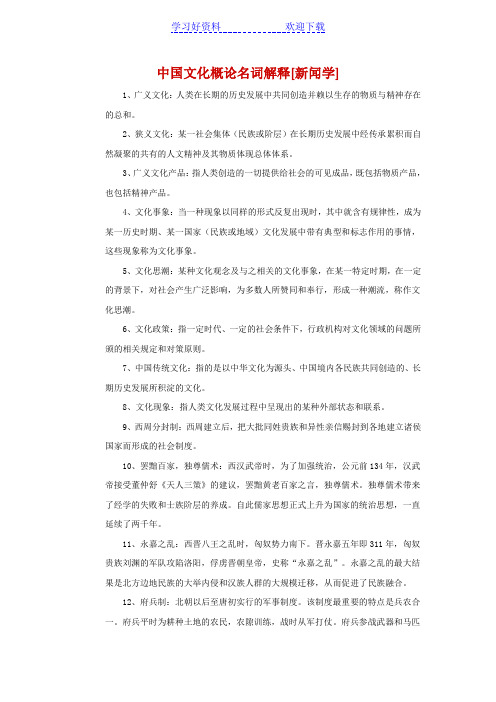
中国文化概论名词解释[新闻学]1、广义文化:人类在长期的历史发展中共同创造并赖以生存的物质与精神存在的总和。
2、狭义文化:某一社会集体(民族或阶层)在长期历史发展中经传承累积而自然凝聚的共有的人文精神及其物质体现总体体系。
3、广义文化产品:指人类创造的一切提供给社会的可见成品,既包括物质产品,也包括精神产品。
4、文化事象:当一种现象以同样的形式反复出现时,其中就含有规律性,成为某一历史时期、某一国家(民族或地域)文化发展中带有典型和标志作用的事情,这些现象称为文化事象。
5、文化思潮:某种文化观念及与之相关的文化事象,在某一特定时期,在一定的背景下,对社会产生广泛影响,为多数人所赞同和奉行,形成一种潮流,称作文化思潮。
6、文化政策:指一定时代、一定的社会条件下,行政机构对文化领域的问题所颁的相关规定和对策原则。
7、中国传统文化:指的是以中华文化为源头、中国境内各民族共同创造的、长期历史发展所积淀的文化。
8、文化现象:指人类文化发展过程中呈现出的某种外部状态和联系。
9、西周分封制:西周建立后,把大批同姓贵族和异性亲信赐封到各地建立诸侯国家而形成的社会制度。
10、罢黜百家,独尊儒术:西汉武帝时,为了加强统治,公元前134年,汉武帝接受董仲舒《天人三策》的建议,罢黜黄老百家之言,独尊儒术。
独尊儒术带来了经学的失败和士族阶层的养成。
自此儒家思想正式上升为国家的统治思想,一直延续了两千年。
11、永嘉之乱:西晋八王之乱时,匈奴势力南下。
晋永嘉五年即311年,匈奴贵族刘渊的军队攻陷洛阳,俘虏晋朝皇帝,史称“永嘉之乱”。
永嘉之乱的最大结果是北方边地民族的大举内侵和汉族人群的大规模迁移,从而促进了民族融合。
12、府兵制:北朝以后至唐初实行的军事制度。
该制度最重要的特点是兵农合一。
府兵平时为耕种土地的农民,农隙训练,战时从军打仗。
府兵参战武器和马匹自备。
全国都有负责府兵选拔训练的折冲府。
唐朝有强劲的军事实力主要在于它有精良的府兵和尚武精神。
中国文化概论(名词解释)

中国文化概论(名词解释)1.广义的文化:(1)指的是人类在长期的历史发展中共同创造的并赖以生存的物质和精神存在的总和。
(2)分为物质的、精神的和制度的三个方面。
2.狭义的文化:(1)又称人文文化。
(2)指社会的意识形态,即人类的精神创造,它着重人的心态部分。
(3)如文学、艺术、教育、科学等等。
3.文化产品:(1)有广狭二义之分。
(2)广义的文化产品指的是人类创造的一切提出供给社会的可见成品,既包括物质产品,也包括精神产品。
(3)狭义的文化产品专指精神产品。
(4)纯粹实用的生产工具、生活器具、能源资材等,一般不称为文化产品。
4.文化内涵:(1)指的是一些不属于狭义文化的事物中所具有的人文特性。
(2)平时所说的筷子文化,扇子文化等等是针对所指称事物的文化内涵现时言的。
5.文化现象:(1)指人类文化发展过程中呈现出的某种外部状态和联系。
(2)其特点有个别、具体、可直接观察和经验性等。
6.文化事象:(1)当一种现象以同样的形式反复出现时,其中就含有规律性,成为某一历史时期、某一国家(民族或地域)文化发展中带有典型和标志作用的事情,这些现象称为文化事象。
(2)它是人们对现象的感受上升到理性概括的认识产物。
如行业禁忌、建安风骨、原始巫术等。
(3)它具有类型性和文化变异性的特点,文化事象的功能具有时代性。
7.文化思潮:(1)某种文化观念及与之相关的文化事象,在某一特定时期,在一定的背景下,对社会产生广泛影响,为多数人所赞同和奉行,形成一种潮流,称作文化思潮。
(2)梁启超认为,汉代的经学、隋唐的佛学、宋明的理学清代的考据学等,都可以看做是时代思潮。
8.文化政策:(1)指一定时代,一定的社会条件下,行政机构对文化领域的问题所颁布的相关规定和对策原则。
(2)针对少数民族发展的民族政策、文艺政策、宗教政策、语言文字政策等等,均属于此。
(3)正确的文化政策能促进和推动其发展,反之,错误的文化政策能阻碍和破坏其发展。
9.上层文化:(1)指宫廷文化与上层文人所创造、拥有的文化。
中国文化概论名词解释

1、广义文化:文化是人类在长期的历史发展中共同创造并赖以生存的物质与精神存在的总和。
广义文化是与人类及人类的创造活动相联系的,是以人为中心的概念;广义文化是一个历史概念,它涵盖人类历史的全过程,是一个传承发展的综合概念;广义文化的外延涵盖物质创造和精神创造的全部。
2、狭义文化:狭义文化又称人文文化,是某一社会集体(民族或阶层)在长期历史发展中经传承积累而自然凝聚的共有的人文精神及其物质体现总体体系。
狭义文化不但以人为中心,而且以人的精神活动为中心,即使观察物化世界,也是以其中的人文精神为内核的;狭义文化关注的不是个别人的精神活动,而是经历史传承累积凝聚的共有的、成体系的人文精神;狭义文化关注的不仅是全人类的普遍共性,而且更注重不同民族、阶层、集团人文精神的特点。
3、文化产品:广义的文化产品指人类创造的一切提供给社会的可见成品,既包括物质产品,也包括精神产品。
狭义的文化产品专指精神产品,它是写成的典籍或成为口头流传的语言形式的纯粹的思想观念的产物。
4、文化内涵:我们把一些不属于狭义文化的事物中所具有的人文特性,称为事物的文化内涵。
5、文化现象:指人类文化发展过程中呈现出的某种外部状态和联系。
6、文化事象:当一种现象以同样的形式反复出现时,其中就含有规律性,成为某一历史时期、某一国家(民族或地域)文化发展中带有典型和标志作用的事情,这些现象称为文化事象。
文化事象往往是思想观念及其物化形式的综合,它不但具有外在的特色,而且含有观念的特色。
文化事象是人们对现象的感受上升到理性概括的认识产物。
7、文化观念:一个时期某一阶层或某一行业的人群对文化问题所持的态度和看法,或在某一文化事象里所表现的意识形态,诸如价值观、审美观等等,称作文化观念。
8、文化思潮:某种文化观念及与之相关的文化事象,在某一特定时期,在一定的背景下,对社会产生广泛影响,为多数人所赞同和奉行,形成一种潮流,称作文化思潮。
9、文化政策:指一定时代、一定的社会条件下,行政机构对文化领域的问题所颁布的相关规定和对策原则。
00321中国文化概论:名词解释—小抄版-

00321中国文化概论:名词解释—小抄版绪论一、文化:是人类在长期的历史发展中共同创造并赖以生存的物质与精神存在的总和。
二、狭义文化:是某一社会集体(民族或阶层)在长期历史发展中经传承累积而自然凝聚的共有的人文精神及其物质体现总体体系。
三、文化产品:广义的文化产品指人类创造的一切提供给社会的可见成品,既包括物质产品,也包括精神产品,狭义专指精神产品。
四、文化内涵:一些不属于狭义文化的事物中所具有的人文特性。
五、文化现象:指人类文化发展过程中呈现的某种外部状态和联系。
六、文化事象:当一种现象以同样的形式反复出现时,其中就含有规律性,成为某一历史时期、某一国家(民族或地域)文化发展中带有典型性和标志作用的事情。
七、文化思潮:某种文化观念及与之相关的文化事象,在某一特定时期,在一定的背景下,对社会产生广泛影响,为多数人所赞同和奉行,形成一种潮流。
八、文化政策:指一定时代、一定的社会条件下,行政机构对文化领域的问题所颁布的相关规定和对策原则。
九、上层文化:指宫廷文化与上层文人所创造、拥有的文化,底层文化指民间文化,即不依赖于统治阶级的广大人民及其精英人物所创造、拥有的文化。
十、中国传统文化:指的是中华文化为源头、中国境内各民族共同创造的,长期历史发展所积淀的文化。
十一、中国文化概论的基本内容:1.有关文化的一般概念 2.中国文化赖以存在的地理环境 3.中国文化发展的历史脉络以及决定历史发展的诸因素 4.有关中国文化分科的知识 5.中国文化在世界文化中的地位 6.中国传统文化与现代社会。
第一章:中国文化的地理背景一、山西“天下形势”:历来是北方草原民族进入中原地带的要冲,太行山脉中某些断裂处,又可以直通华北地区,是内迁北方民族进入中原地区的要路。
二、中国地理的整体性特征:不失大陆的整体性 1.众多的河流犹如血脉一样,将大陆广大的地区联系在一起。
2.地理通道三、地理条件对中国文化的诸多影响1.广大地域决定中国文化的道路和文化方向 2.广大地域形成的“大一统”观念3.地缘特征与中国文化的历史命运。
中国传统文化概观(名词解释及论述资料)

名词解释1,广义文化:它是指人类在长期的历史发展中共同创造并赖以生存的物质与精神存在的总和。
2.狭义文化:又称人文文化。
它是某一社会集体(民族或阶层)在长期历史发展中经传承属积而自然凝聚的共有的人文精神及其物质体现总体体系。
1,中国传统的整体思维:是一种重整体、重领悟、以经验为基础的直观思维。
它把天、地、人、社会看作密切贯通的整体,认为天地人我、人身人心都处在一个整体系统之中,各系统要素之间存在着相互依存的联系。
2.中国古代类比思维:类比思维是指依据事物(包括天地人、万物)的外部特征或内在属性进行比照与联系的思维方式、中国传统思维善于抓住事物之间的某种相关进行类比象征,以达到由此及彼、由近及远地分析与表述的目的。
3.中国古代辩证思维:辩证思维就是运用对立而统一的观点、方法来认识、分析各种自然现象及其变化。
中国古代辩证思维来源于对天地万物两两对立而又统一的自然现象的考察与理解。
4.天人合一:主要包含两层意义:第一层意义是,人是天地生成的,人的生活服从自然界的普遍规律。
第二层意义是,自然界的普通规律和人类道德的最高原则;是一而二、二而一的。
这是中国传统哲学的一个独特的观点,起源于西周时代。
5、中庸:意为“中是可以长久行用的典法”。
它是中国传统文化的最高价值原则,是由孔子提出来的。
“中庸之道”又可称为“中和之道”,它要求人们做什么事情都不要过激,要求其适中,“无偏无颇”。
6.中和:意为“经过对两端的调整而达到和谐”。
要在“两端”(如高低、长短、大小等)里面“允执其中”,即确实把握好“中”,就需要往返地调整以渐趋于和谐。
9.五常:是由董仲舒提出来的,指仁、义、礼、智、信五种道德规范。
10、五伦十教.是孟子对君臣、父子、夫妇、兄弟、朋友提出的行为规范:君惠臣忠、父慈子孝、兄友弟恭、夫义妇顺、朋友有信。
11.前兆迷信:是原始宗教的一部分,指用神意或神秘力量来解释前兆现象与未来事物之间的联系,是古代占卜发生的基础。
中国文化名词解释

中国文化名词解释
中国文化名词解释示例如下:
1. 儒家文化:儒家文化是中国传统文化中的重要组成部分,源于中国古代思想家孔子及其弟子的思想体系。
儒家文化强调个体的道德修养、人际关系、家庭伦理、社会正义等方面,并主张通过教育来实现人的完善和发展。
2. 道家文化:道家文化是中国传统文化中的重要组成部分,源于中国古代思想家老子的思想体系。
道家文化强调个体的自我修养、心灵自由、自然和谐等方面,并主张通过无为而治来实现宇宙的和谐与人类的进步。
3. 佛教文化:佛教文化是中国传统文化中的重要分支,源于中国古代印度。
佛教文化强调个体的解脱、智慧和慈悲,并倡导通过修行来实现心灵的净化和心灵的自由。
4. 武术文化:武术文化是中国传统文化中的重要组成部分,源于中国古代武术家的思想和实践。
武术文化强调身体的健康、精神的修养和技巧的提高,并有多种流派和形式。
5. 传统节日:中国传统文化中有许多重要的传统节日,如春节、清明节、端午节、中秋节等。
这些节日强调家庭团聚、祭祀祖先、祈福安康和表达情感等方面,具有深厚的文化内涵和历史渊源。
除了以上列举的文化名词,中国传统文化中还有许多其他重要的组成部分,如诗词文化、书法文化、绘画文化、民间艺术等。
这些文化名词都代表着中国传统文化的独特魅力和精髓,是中国文化的重要组成部分。
名词解释中国文化

名词:中国文化
解释:中国文化,是华夏文明为基础,充分整合全国各地域和各民族文化要素而形成的文化。
不同于中华文化的国际属性,可以称之为“中国的文化”(中华人民共和国的文化)。
受中华文明影响较深的东方文明体系被称为“汉文化圈”,特指社会意识形态,是社会政治、经济与科学技术发展水平的反映。
从旧石器时代的发明创造,到康有为梁启超的维新变法到孙中山的民主革命无一不是推动社会向前发展的动力。
中国文化,依据中国历史大系表相传经历了有巢氏、燧人氏、伏羲氏、神农氏(炎帝)、黄帝(轩辕氏)、尧、舜、禹等时代,《先秦史》载:“吾国开化之迹,可征者始于巢、燧、羲、农。
” ;到中国第一个国家夏朝建立。
发展以来,一个拥有灿烂文化的中国,带着丰富多彩的文化元素屹立在世界东方。
中国文化概况
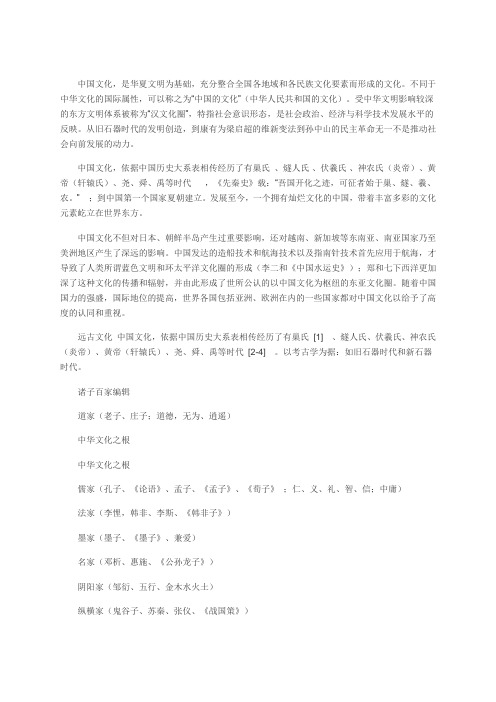
中国文化,是华夏文明为基础,充分整合全国各地域和各民族文化要素而形成的文化。
不同于中华文化的国际属性,可以称之为“中国的文化”(中华人民共和国的文化)。
受中华文明影响较深的东方文明体系被称为“汉文化圈”,特指社会意识形态,是社会政治、经济与科学技术发展水平的反映。
从旧石器时代的发明创造,到康有为梁启超的维新变法到孙中山的民主革命无一不是推动社会向前发展的动力。
中国文化,依据中国历史大系表相传经历了有巢氏、燧人氏、伏羲氏、神农氏(炎帝)、黄帝(轩辕氏)、尧、舜、禹等时代,《先秦史》载:“吾国开化之迹,可征者始于巢、燧、羲、农。
”;到中国第一个国家夏朝建立。
发展至今,一个拥有灿烂文化的中国,带着丰富多彩的文化元素屹立在世界东方。
中国文化不但对日本、朝鲜半岛产生过重要影响,还对越南、新加坡等东南亚、南亚国家乃至美洲地区产生了深远的影响。
中国发达的造船技术和航海技术以及指南针技术首先应用于航海,才导致了人类所谓蓝色文明和环太平洋文化圈的形成(李二和《中国水运史》);郑和七下西洋更加深了这种文化的传播和辐射,并由此形成了世所公认的以中国文化为枢纽的东亚文化圈。
随着中国国力的强盛,国际地位的提高,世界各国包括亚洲、欧洲在内的一些国家都对中国文化以给予了高度的认同和重视。
远古文化中国文化,依据中国历史大系表相传经历了有巢氏[1] 、燧人氏、伏羲氏、神农氏(炎帝)、黄帝(轩辕氏)、尧、舜、禹等时代[2-4] 。
以考古学为据:如旧石器时代和新石器时代。
诸子百家编辑道家(老子、庄子;道德,无为、逍遥)中华文化之根中华文化之根儒家(孔子、《论语》、孟子、《孟子》、《荀子》;仁、义、礼、智、信;中庸)法家(李悝,韩非、李斯、《韩非子》)墨家(墨子、《墨子》、兼爱)名家(邓析、惠施、《公孙龙子》)阴阳家(邹衍、五行、金木水火土)纵横家(鬼谷子、苏秦、张仪、《战国策》)杂家(吕不韦)(《吕氏春秋》)农家兵家医家儒家文化儒家文化文化分支编辑琴:笛子、二胡、古筝、箫、鼓、古琴、琵琶。
中国文化概论名词解释
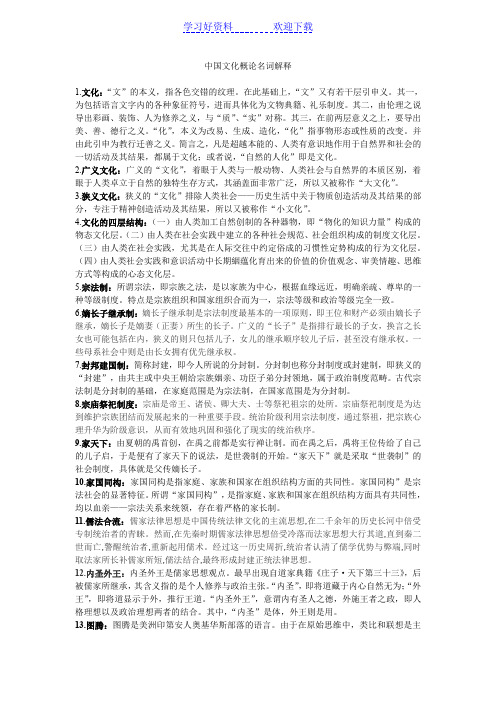
中国文化概论名词解释1.文化:“文”的本义,指各色交错的纹理。
在此基础上,“文”又有若干层引申义。
其一,为包括语言文字内的各种象征符号,进而具体化为文物典籍、礼乐制度。
其二,由伦理之说导出彩画、装饰、人为修养之义,与“质”、“实”对称。
其三,在前两层意义之上,要导出美、善、德行之义。
“化”,本义为改易、生成、造化,“化”指事物形态或性质的改变。
并由此引申为教行迁善之义。
简言之,凡是超越本能的、人类有意识地作用于自然界和社会的一切活动及其结果,都属于文化;或者说,“自然的人化”即是文化。
2.广义文化:广义的“文化”,着眼于人类与一般动物、人类社会与自然界的本质区别,着眼于人类卓立于自然的独特生存方式,其涵盖面非常广泛,所以又被称作“大文化”。
3.狭义文化:狭义的“文化”排除人类社会——历史生活中关于物质创造活动及其结果的部分,专注于精神创造活动及其结果,所以又被称作“小文化”。
4.文化的四层结构:(一)由人类加工自然创制的各种器物,即“物化的知识力量”构成的物态文化层。
(二)由人类在社会实践中建立的各种社会规范、社会组织构成的制度文化层。
(三)由人类在社会实践,尤其是在人际交往中约定俗成的习惯性定势构成的行为文化层。
(四)由人类社会实践和意识活动中长期絪蕴化育出来的价值的价值观念、审美情趣、思维方式等构成的心态文化层。
5.宗法制:所谓宗法,即宗族之法,是以家族为中心,根据血缘远近,明确亲疏、尊卑的一种等级制度。
特点是宗族组织和国家组织合而为一,宗法等级和政治等级完全一致。
6.嫡长子继承制:嫡长子继承制是宗法制度最基本的一项原则,即王位和财产必须由嫡长子继承,嫡长子是嫡妻(正妻)所生的长子。
广义的“长子”是指排行最长的子女,换言之长女也可能包括在内,狭义的则只包括儿子,女儿的继承顺序较儿子后,甚至没有继承权。
一些母系社会中则是由长女拥有优先继承权。
7.封邦建国制:简称封建,即今人所说的分封制。
分封制也称分封制度或封建制,即狭义的“封建”,由共主或中央王朝给宗族姻亲、功臣子弟分封领地,属于政治制度范畴。
- 1、下载文档前请自行甄别文档内容的完整性,平台不提供额外的编辑、内容补充、找答案等附加服务。
- 2、"仅部分预览"的文档,不可在线预览部分如存在完整性等问题,可反馈申请退款(可完整预览的文档不适用该条件!)。
- 3、如文档侵犯您的权益,请联系客服反馈,我们会尽快为您处理(人工客服工作时间:9:00-18:30)。
中国文化概况名词解释SAR=special administrative regionsWas established specially designed for solving Hong Kong and Macao issues based o n the concept of “One country, two systems” SAR is in a pattern with which two com pletely different social systems and ideologies can coexist. SAR has more autonomou s power regulated clearly by laws, including executive, legislative and independent ju dicial power.Family planning policySince the late 1970s, the Chinese government has been implementing a policy of fami ly planning, to control the population increase. Improve population quality, promote t he development of the economy and society, and protect the environment. The family planning policy has seen remarkable achievements.Campaign of” banning all schools of thought except Confucianism”In the Han dynasty, Emperor Wudi instituted the campaign. He ruled out various scho ols of thought and chose officials from those who were steeped in Confucianism only. Consequently, Confucianism became an orthodox school that served as the ideologica l foundation of the feudal rule throughout the dynasties in china.The three obedience and four virtues.These were the old moral standards imposed upon women in feudal society. The tradit ional ideal of a woman is that she is a dependent being whose behavior is governed by “three obedience” (to father before marriage, to husband after marriage, and to son af ter becoming a widow) and “four virtues” (morality, proper speech, modest manner, a nd diligence.A hundred schools of thought contendThe Spring and Autumn and the Warring State Periods (770-221BC) were a time of gr eat social change, stimulating various schools of thought, such as Confucianism, Lega lism, Taoism and Monism. And scholars wrote, lectured and debated vigorously, creati ng a lively academic environment later described as “a hundred schools of thought co ntend.”The Foolish Man Moving MountainAn ancient Chinese fable known to every household in china. The story tells of an old man who led the whole family in dragging away the big mountains obstructing the pa th. He said they would definitely be removed by the continuous efforts of his descend ants. The story encourages people to do things with perseverance and to defy difficulti es.Shadow playIs one of the most ancient genres of drama in China. It came into being in the Han Dy nasty, having more than 2000 years history. The performance manipulates colorful lea ther or cardboard figures whose silhouettes are reflected on a careen by lantern light. The silhouettes are seen to perform behind on the screen while the real performers ope rate the silhouettes sing to the accompaniment of music behind the scene.Paper making processIn the Eastern Han Dynasty, a court official named Cai Lun(cheap, light, thin, durable, for brush written, more suitable, use inexpensive materials such as bank, hemp, rags, fishnet, wheat, stalks and other materials to make paper, known as Cai Lun paper. The materials were soaked, cut into pieces, boiled with plant ash, washed, and ground wit h a pestle in a mortar. The mixture was then poured evenly on a flat surface to dry, or baked to become paper)Chinese people’s food choiceChina is a vast country with diverse climates, customs, products, and habits. Favored dishes vary from region to region. People in coastal areas prefer seafood arid aquatic(水产的)products, whereas those in central and northwest China eat more domestic animals and poultry. Foods vary from north to south. Tastes also differ regionally because of t he climatic differences. One popular summary ofChinese food is "sweet in the south, salty in the north, sour in the west anti spicy in th e east".Huabiao(华表)Are paired ceremonial columns erected in front of a palace or tomb, etc. usually carve d with dragon and phoenix patterns, with a transverse-engraved stone slab on its top. I t can be up to 20 meters in height and a mater or so in diameter. A typical Huabiao has a round or octagonal base. The columns behind the gate are named” wangjunchu ”, w hile Huabiaos in front are named “wangjungui”Paifang(牌坊)Paifang, also called pailou, is an archway usually made from fine wood or stone, and painted or decorated with glazed tiles. Calligraphers are usually requested to write mo ral inscriptions to be carved into middle beam. These structures usually stand in down town areas, or at the entrances of mausoleums, temples, bridges and parks.Food’s yin-yang principleChinese hold that everything in the universe is either positive or negative, hot or cold, wet or dry, etc. so people think the food they eat will keep a harmonious balance of th ese cosmic forces if they want to stay physically, emotionally and spiritually healthy. Each food has its own characteristics of yin or yang. Yin foods are thin, cooling and lo w in calories. Yang foods are rich, spicy, warming and high in calories. Boring food m akes them yin, while frying them makes them yang. So the Chinese cuisines always b alance the two. It’s said that all main food colours should be included in a meal, to ens ure a range of nutrients.。
